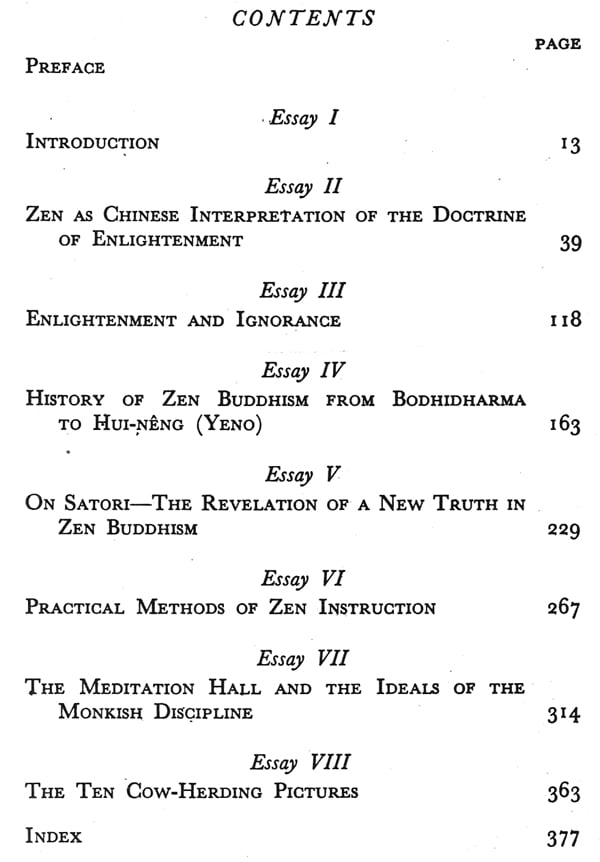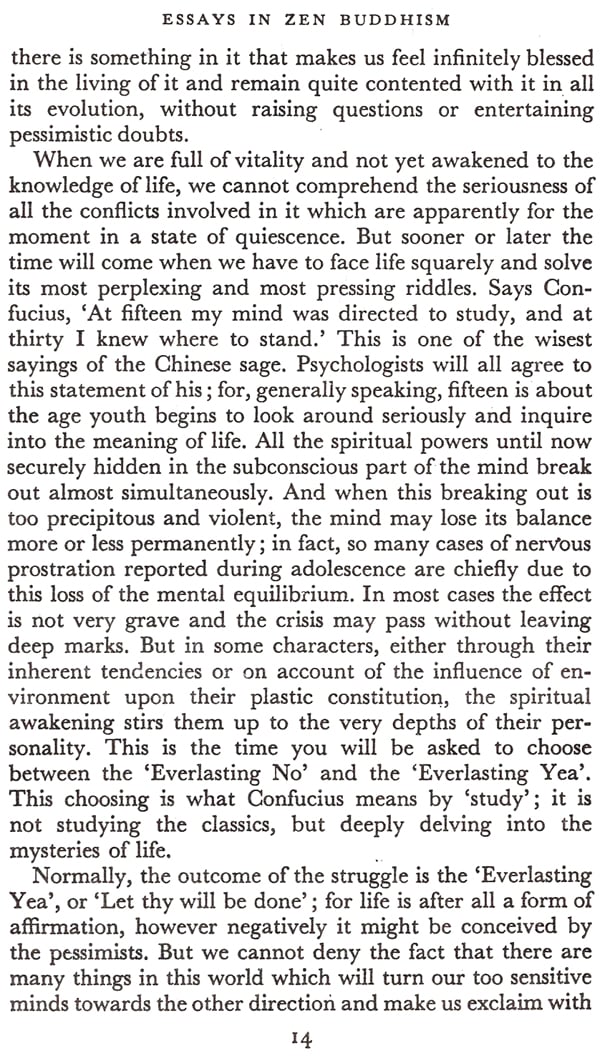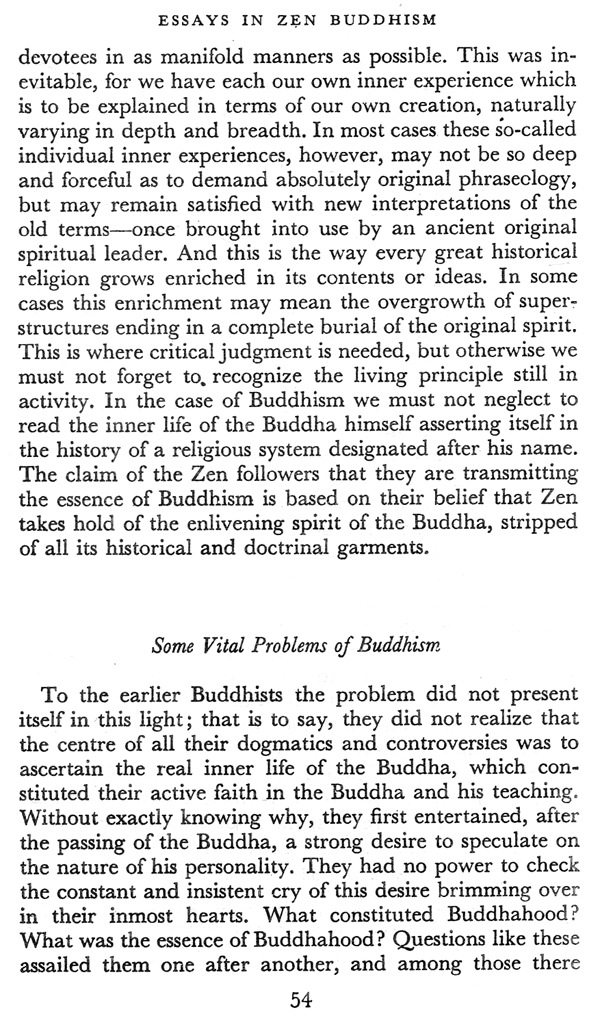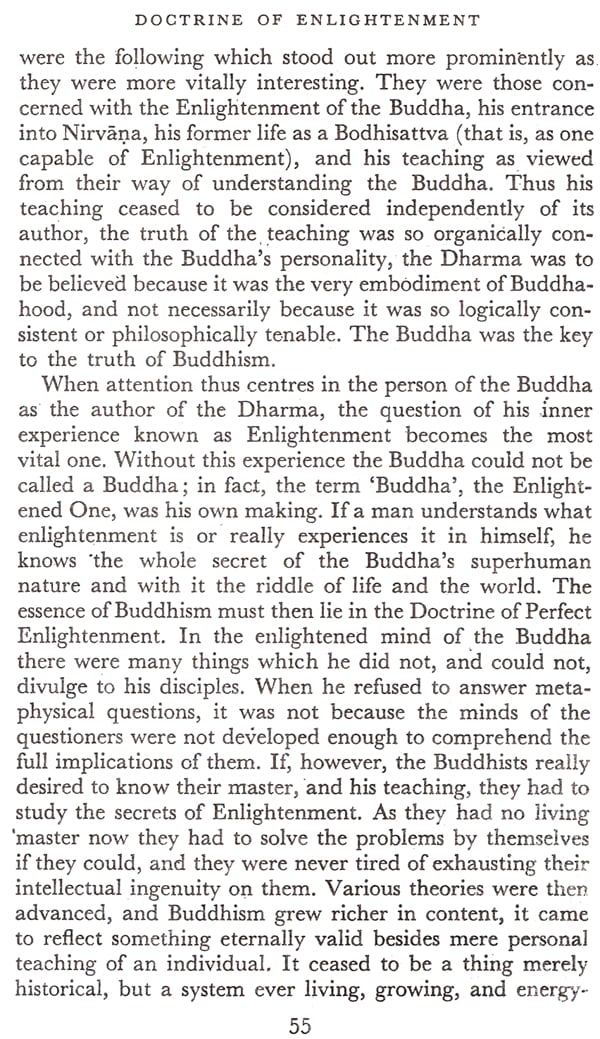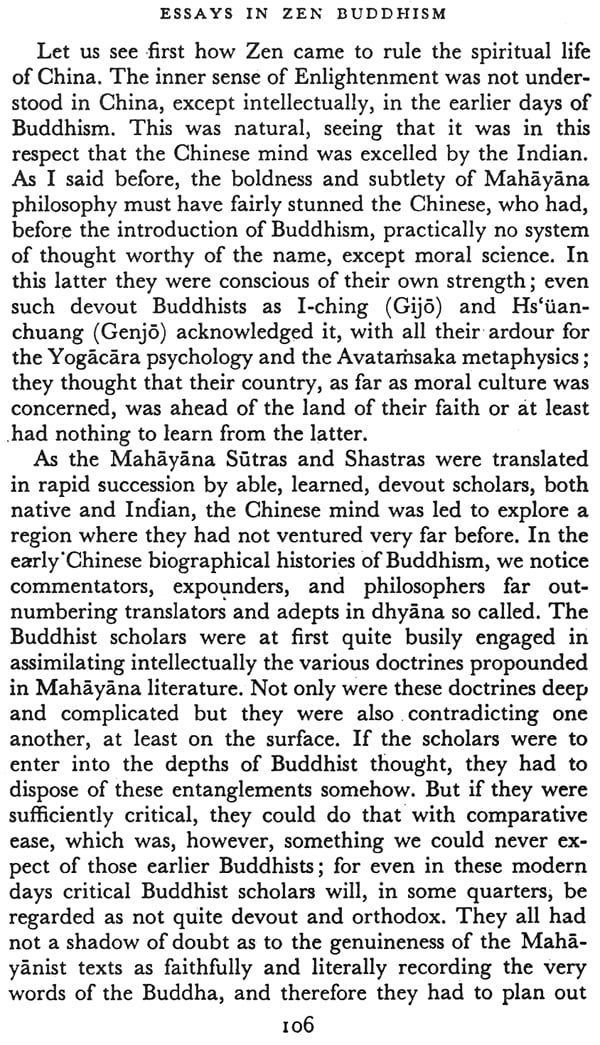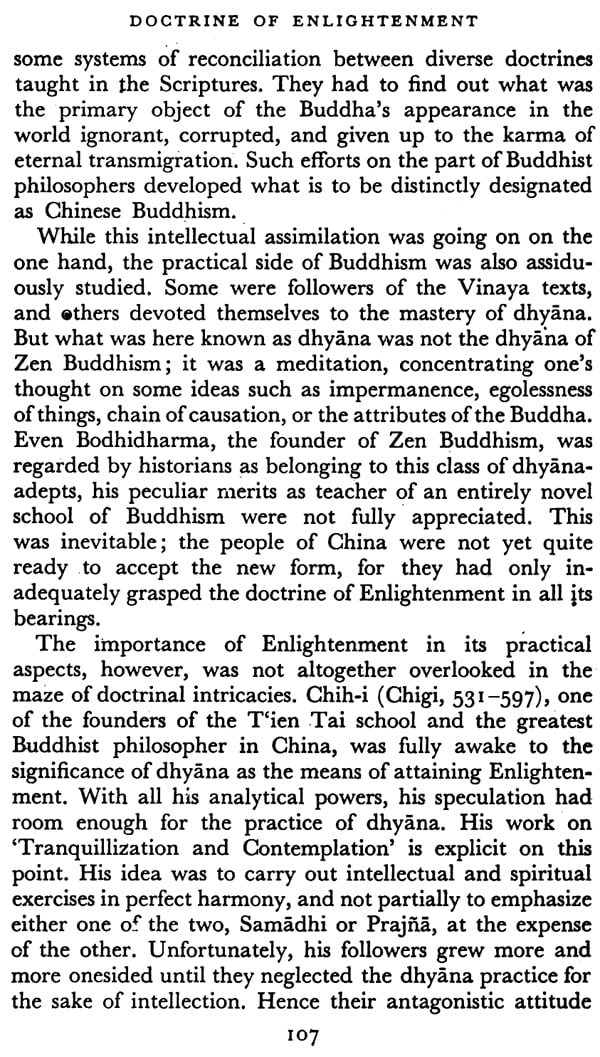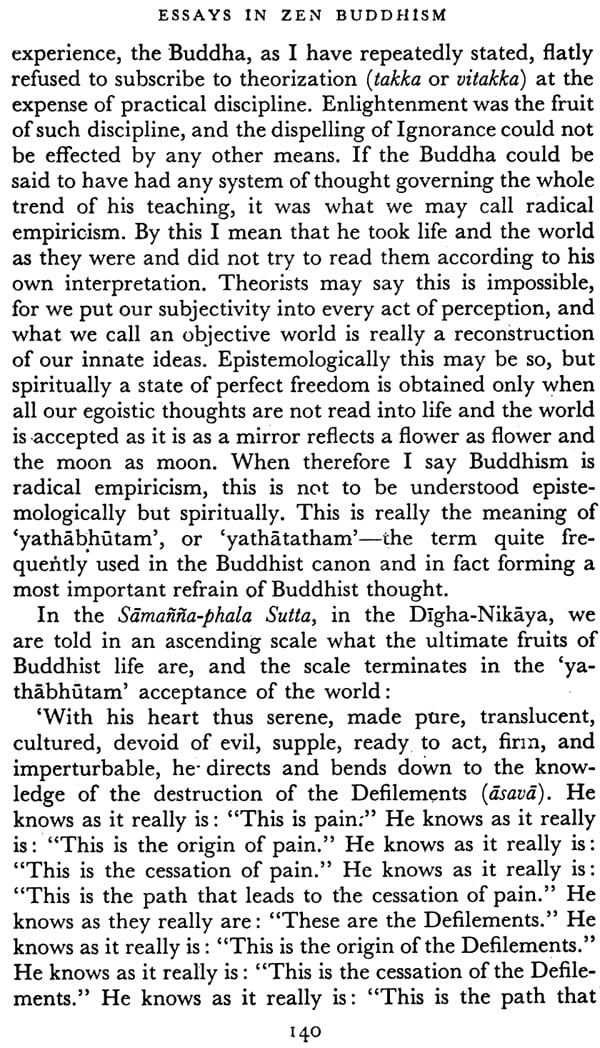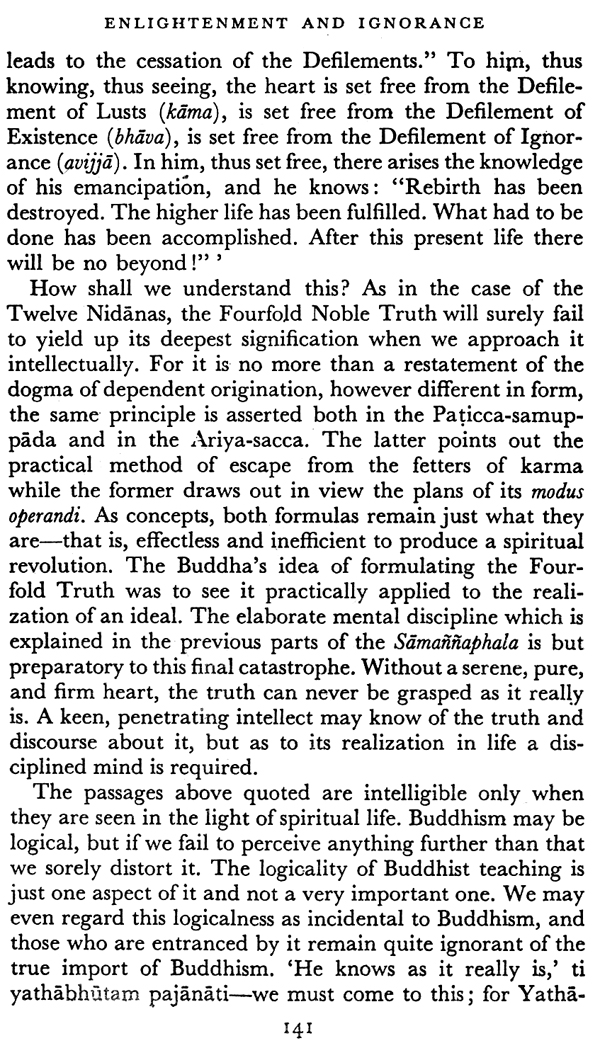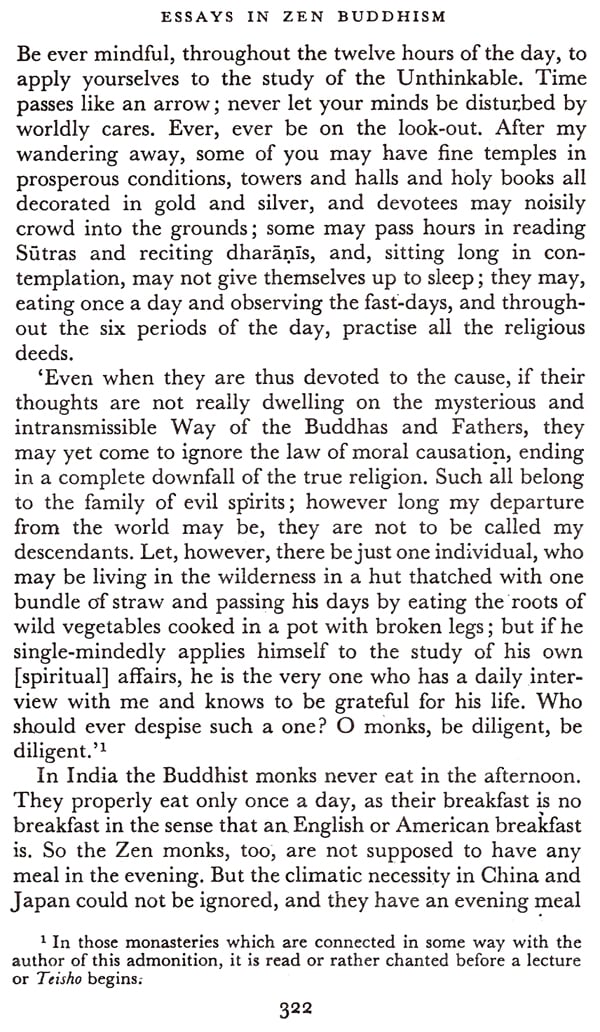
Essays in Zen Buddhism First Series
Book Specification
| Item Code: | NAU576 |
| Author: | D.T. Suzuki |
| Publisher: | New Age Books |
| Language: | English |
| Edition: | 2017 |
| Pages: | 388 |
| Cover: | PAPERBACK |
| Other Details | 8.50 X 5.50 inch |
| Weight | 310 gm |
Book Description
ESSAYS IN ZEN BUDDHISM (Second Series) Zen Buddhism is a unique school of spiritual development which uses many systems of philosophy, psychology, and ethics in the course of its own technique of Sudden Enlightenment. This volume contains the Second Series of the author's famous Essays in Zen Buddhism, including those on the Koan, the Secret Message of Bodhidharma, and Passivity in the Buddhist Life. In this Second Series of Zen Essays, the chief stress has been placed on the study of 'The Koan Exercise', which at present constitutes almost the alpha and omega of Zen discipline, especially as it is practised in the Rinzai School of the Zen sect. The koan technique is full of pitfalls, but its development was inevitable, and without it Zen might not have survived. My study of the koan exercise as presented in this Series is not a very complete one, but I hope I have given the reader a general idea of what it is. I further hope that the psychologist and the philosopher will take up this study as facts of experience specifically developed in the Far-eastern mind.
D.T. Suzum, (also written Daisetz) in full Daisetsu .Teitaro Suzuki, born Oct 18, 1870, Kanazawa Japan - died July 12, 1966, Kamakura, was a Japanese philosopher and author of Books and Essays on Buddhism, Zen and Shin that were instrumential in spreading interest in both Zen and Shin (and for Eastern Philosophy in general) to the west. Suzuki, was also a prolific translator of Chinese, Japanese, and Sanskrit literature. Suzuki spent several lengthy stretches teaching or lecturing at Western universities and devoted 'many years to a professorship in a Japanese Buddhist University, Otani. He was a best key figure in the introduction of Buddhism to the nen-Asian world.
The most fruitful growth of Buddhism in the Far East has resulted in the development of Zen and Shin. Zen attained its maturity in China and Shin in Japan. The vigour and vitality which Buddhism still has after more than two thousand years of history will be realized when one comes in contact with these two branches of Buddhism. The one appeals to the inmost religious consciousness of mankind, while the other touches the intellectual . and practical aspects of the Oriental mind, which is more intuitive than discursive, more mystical than logical. If Zen is the ultra 'self-power' wing of Buddhism, Shin represents the other extreme wing known as the 'other-power', and these two extremes are synthesized in the enlightened Buddha-consciousness. Since the publication of my short note on Zen Buddhism in the Journal of the Pali Text Society, 19o7, nothing of im-portance has been published in English on the subject except Professor Kwaiten Nukariya's Religion of the Samurai, 1913. In fact, even in Japanese or Chinese, this branch of Buddhism has received very slight attention from modern writers of Buddhism. This is due to the peculiar difficulties which accompany the study of it. The `Goroku' (sayings) is the only literary form in which Zen expresses itself; and to understand it requires some special practical training in Zen, for mere knowledge of the Chinese, classical and historical, is far from being enough ; even with the masterly understanding of-the philosophy of general Buddhism, Zen is found quite hard to fathom. Some of such scholars some-times try to explain the truth and development of Zen, but they sadly fail to do justice to the subject. On the other hand, the Zen masters so called are unable to present their understanding in the light of modern thought. Their most intellectually productive years are spent in the Meditation Hall, and when they successfully graduate from it they are looked up to as adepts thoroughly versed in the koans. So far so good ; but, unfortunately from the scholarly point of view, they remain contented with this, and do not show any lively intellectual interest in the psychology and philosophy of Zen. Thus Zen is left to lie quietly sealed up in the 'Sayings' of the masters and in the technical study of the koans , it is thus incapacitated to walk out of the seclusion of the cloisters. Of course, great mistake it would be if one should ever take the notion even for a moment that Zen could be mastered from its philosophical presentation or its psychological description; but this ought not to mean that Zen is not to be intelligently approached or to be made some-what accessible by our ordinary means of reasoning. I need not mention that my attempts in the following pages are anything but adequate for the rational treatment of the subject. But as a tentative experiment to present Zen from our common-sense point of view and as a direct lineage of Buddhist faith as first proclaimed, or rather realized, by the Buddha, I hope I have worked towards removing some of the difficulties usually besetting us in the mastery of Zen thought. How far I have succeeded or how utterly I have failed—this is naturally for the reader to judge. The book is a collection of the Essays originally published in The Eastern Buddhist, except one on the 'History of Zen Buddhism' which was written specially for this volume ; but all of them have been thoroughly revised and in some parts entirely rewritten and new chapters added. The book will be followed by a second series of Essays before long, in which some more of the important points in the constitution of Zen will be treated. The publication of these Essays in book form is principally due to the most liberal encouragement, both material and moral, of Mr. Yakichi Ataka, of Osaka, who is an old friend of the author's and who has not forgotten the pledge half seriously and half dreamily made in our youthful days.
ZEN in its essence is the art of seeing into the nature of one's own being, and it points the way from bondage to freedom. By making us drink right from the fountain of life, it liberates us from all the yokes under which we finite beings are usually suffering in this world. We can say that Zen liberates all the energies properly and naturally stored in each of us, which are in ordinary circumstances cramped and distorted so that they find no adequate channel for activity. This body of ours is something like an electric battery in which a mysterious power latently lies. When this power is not properly brought into operation, it either grows mouldy and withers away or is warped and expresses itself abnormally. It is the object of Zen, therefore, to save us from going crazy or being crippled. This is what I mean by freedom, giving free play to all the creative and benevolent impulses inherently lying in our hearts. Generally, we are blind to this fact, that we are in possession of all the necessary faculties that will make us happy and loving towards one another. All the struggles that we see around us come from this ignorance. Zen, therefore, wants us to open a 'third eye', as Buddhists call it, to the hitherto un-dreamed-of region shut away from us through our own ignorance. When the cloud of ignorance disappears, the infinity of the heavens is manifested, where we see for the first time into the nature of our own being. We now know the signification of life, we know that it is not blind striving nor is it a mere display of brutal forces, but that while we know not definitely what the ultimate purport of life is, 1 One of the popular lectures prepared by the author for students of Buddhism, 191 r. It was first published in The Eastern Buddhist, under the title, 'Zen Buddhism as Purifier and Liberator of Life'. Since it treats of Zen in its general aspect, I have decided to make it serve as Introduction to this book. There is something in it that makes us feel infinitely blessed in the living of it and remain quite contented with it in all its evolution, without raising questions or entertaining pessimistic doubts. When we are full of vitality and not yet awakened to the knowledge of life, we cannot comprehend the seriousness of all the conflicts involved in it which are apparently for the moment in a state of quiescence. But sooner or later the time will come when we have to face life squarely and solve its most perplexing and most pressing riddles. Says Confucius, 'At fifteen my mind was directed to study, and at thirty I knew where to stand.' This is one of the wisest sayings of the Chinese sage. Psychologists will all agree to this statement of his; for, generally speaking, fifteen is about the age youth begins to look around seriously and inquire into the meaning of life. All the spiritual powers until now securely hidden in the subconscious part of the mind break out almost simultaneously. And when this breaking out is too precipitous and violent, the mind may lose its balance more or less permanently ; in fact, so many cases of nervous prostration reported during adolescence are chiefly due to this loss of the mental equilibrium. In most cases the effect is not very grave and the crisis may pass without leaving deep marks. But in some characters, either through their inherent tendencies or on account of the influence of environment upon their plastic constitution, the spiritual awakening stirs them up to the very depths of their personality. This is the time you will be asked to choose between the 'Everlasting No' and the 'Everlasting Yea'. This choosing is what Confucius means by 'study' ; it is not studying the classics, but deeply delving into the mysteries of life.
**Contents and Sample Pages**
